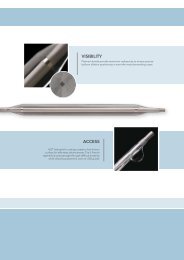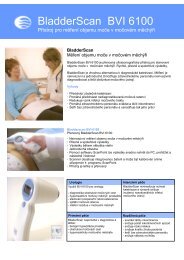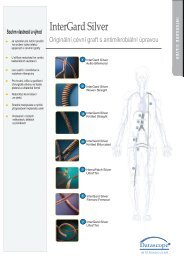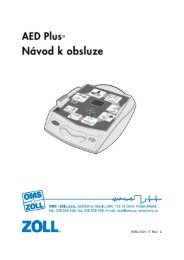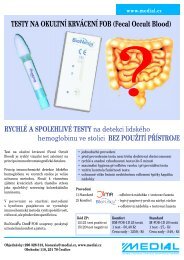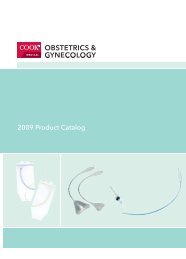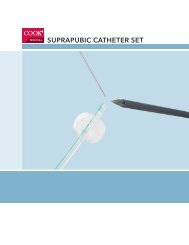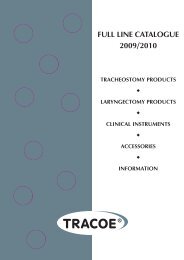The BAP test and the global assessment of oxidative stress ... - Medial
The BAP test and the global assessment of oxidative stress ... - Medial
The BAP test and the global assessment of oxidative stress ... - Medial
You also want an ePaper? Increase the reach of your titles
YUMPU automatically turns print PDFs into web optimized ePapers that Google loves.
absorption <strong>of</strong> nutrients, etc.). In <strong>the</strong>se casesalso, <strong>the</strong> aim <strong>of</strong> <strong>the</strong> <strong>BAP</strong> <strong>test</strong> is to identify <strong>and</strong>to prevent <strong>oxidative</strong> <strong>stress</strong> <strong>and</strong> its unwantedconsequences (early aging, diseases) (57).Moreover, <strong>the</strong> <strong>BAP</strong> <strong>test</strong> should be carriedout on all patients with <strong>oxidative</strong> <strong>stress</strong>-relateddiseases (more than one hundred), such asAlzheimer’s disease, Parkinson’s disease,stroke, infarction, Crohn’s diseases, rheumatoidarthritis, AIDS, some cancers, etc. In all <strong>the</strong>secases, <strong>the</strong> aim <strong>of</strong> <strong>the</strong> <strong>BAP</strong> <strong>test</strong> is to monitor<strong>oxidative</strong> <strong>stress</strong> <strong>and</strong> to prevent itsconsequences, by monitoring <strong>the</strong> efficacy <strong>of</strong>specific <strong>the</strong>rapy, ei<strong>the</strong>r alone or with aconcomitant antioxidant treatment (54). Onthis subject, it must be underlined that in many<strong>of</strong> above mentioned diseases, all almost havinga chronic course, <strong>oxidative</strong> <strong>stress</strong> tends toraise <strong>the</strong> role <strong>of</strong> an additional health riskfactor. <strong>The</strong>refore, it must be controlled in orderto optimize results <strong>of</strong> any treatment. Forinstance, <strong>the</strong> evidence, by means <strong>of</strong> <strong>BAP</strong> <strong>test</strong>,<strong>of</strong> a reduced biological antioxidant potential inhypertensive patients indicates a persistentimpairment <strong>of</strong> physiological defenses againstROS, which can be responsible for anincomplete control <strong>of</strong> <strong>the</strong> current disease by<strong>the</strong> current anti-hypertensive treatment. Sucha finding suggests to <strong>the</strong> clinician an integrated<strong>the</strong>rapeutic approach, in which should be takeplace not only conventional, medical <strong>and</strong>/orsurgical treatments, but also <strong>the</strong> correction <strong>of</strong>life-style <strong>and</strong>, eventually, <strong>the</strong> intake <strong>of</strong>antioxidants.Finally, ideal c<strong>and</strong>idates for <strong>the</strong> <strong>BAP</strong> <strong>test</strong>are all <strong>the</strong> subjects that undergopharmaco<strong>the</strong>rapy (e. g. with chemo<strong>the</strong>rapeuticals,hormone replacement <strong>the</strong>rapy,contraceptive pill, etc.), surgical interventions(e. g. organ transplantation, by-pass, etc.),including dialysis, all conditions being able t<strong>of</strong>avor <strong>oxidative</strong> <strong>stress</strong> by increasing <strong>the</strong> dailyrequirements <strong>of</strong> antioxidants (53, 54).In all <strong>the</strong>se conditions, <strong>the</strong> aim is toidentify <strong>and</strong> to prevent <strong>oxidative</strong> <strong>stress</strong> <strong>and</strong> itsconsequences, <strong>and</strong>, particularly, to monitor <strong>the</strong>efficacy <strong>of</strong> eventual current measures with <strong>the</strong>ultimate objective <strong>of</strong> preventing <strong>oxidative</strong>tissue damage (56).Fur<strong>the</strong>rmore, according to <strong>the</strong> guidelines <strong>of</strong><strong>the</strong> International Observatory <strong>of</strong> OxidativeStress, Free Radicals <strong>and</strong> Antioxidant Systems,<strong>the</strong> <strong>BAP</strong> <strong>test</strong> is very useful, toge<strong>the</strong>r d-ROMs<strong>test</strong>, in <strong>the</strong> so-called <strong>global</strong> <strong>assessment</strong> <strong>of</strong><strong>oxidative</strong> <strong>stress</strong>, now very easy to performgrace to a specific diagnostic algorithm (41,58).In this situation, when d-ROMs value isincreased, an optimal value <strong>of</strong> <strong>BAP</strong> <strong>test</strong> shouldrequire <strong>the</strong> dosing <strong>of</strong> a single antioxidant.Alternatively, if such a dosing is not available,we suggest a mix <strong>of</strong> antioxidants according to<strong>the</strong> RDA tables. This should enable <strong>the</strong>antioxidant defenses to balance <strong>the</strong> increased<strong>oxidative</strong> status, as detected by <strong>the</strong> increasedd-ROMs <strong>test</strong> values, especially when more thanone risk factor is present (e. g. exposition toradiations, cigarette smoke, pollutants, etc.).11. Concluding remarksScientific evidence shows that <strong>BAP</strong> <strong>test</strong> isvery useful in <strong>the</strong> <strong>assessment</strong> <strong>of</strong> antioxidantactivity <strong>of</strong> blood plasma. AAccording to <strong>the</strong> wide available scientificliterature <strong>BAP</strong> <strong>test</strong> was validated by ESR/EPR<strong>and</strong> provided results that largely parallel tothose <strong>of</strong> FRAP <strong>test</strong>, against which it appearsquicker <strong>and</strong> simpler to perform. Indeed, <strong>the</strong>preparation <strong>and</strong> management <strong>of</strong> <strong>the</strong> FRAPreagents is a step somewhat complex,compared to that <strong>of</strong> <strong>BAP</strong> <strong>test</strong>, so that manualprocedure <strong>of</strong> FRAP <strong>test</strong> can increase analyticalvariability. Moreover, a fur<strong>the</strong>r increase <strong>of</strong>analytical accuracy was recently reached by<strong>the</strong> application <strong>of</strong> <strong>BAP</strong> <strong>test</strong> to automaticanalytical devices.Finally, according to <strong>the</strong> novel concept <strong>of</strong><strong>global</strong> <strong>oxidative</strong> <strong>stress</strong> <strong>assessment</strong>, <strong>the</strong> <strong>BAP</strong><strong>test</strong> is a reliable assay able to integrate <strong>the</strong>results <strong>of</strong> d-ROMs <strong>test</strong>, which allows for <strong>the</strong>assessing <strong>of</strong> <strong>the</strong> total oxidant status <strong>of</strong> bloodplasma.18www.fras4evolvo.it



